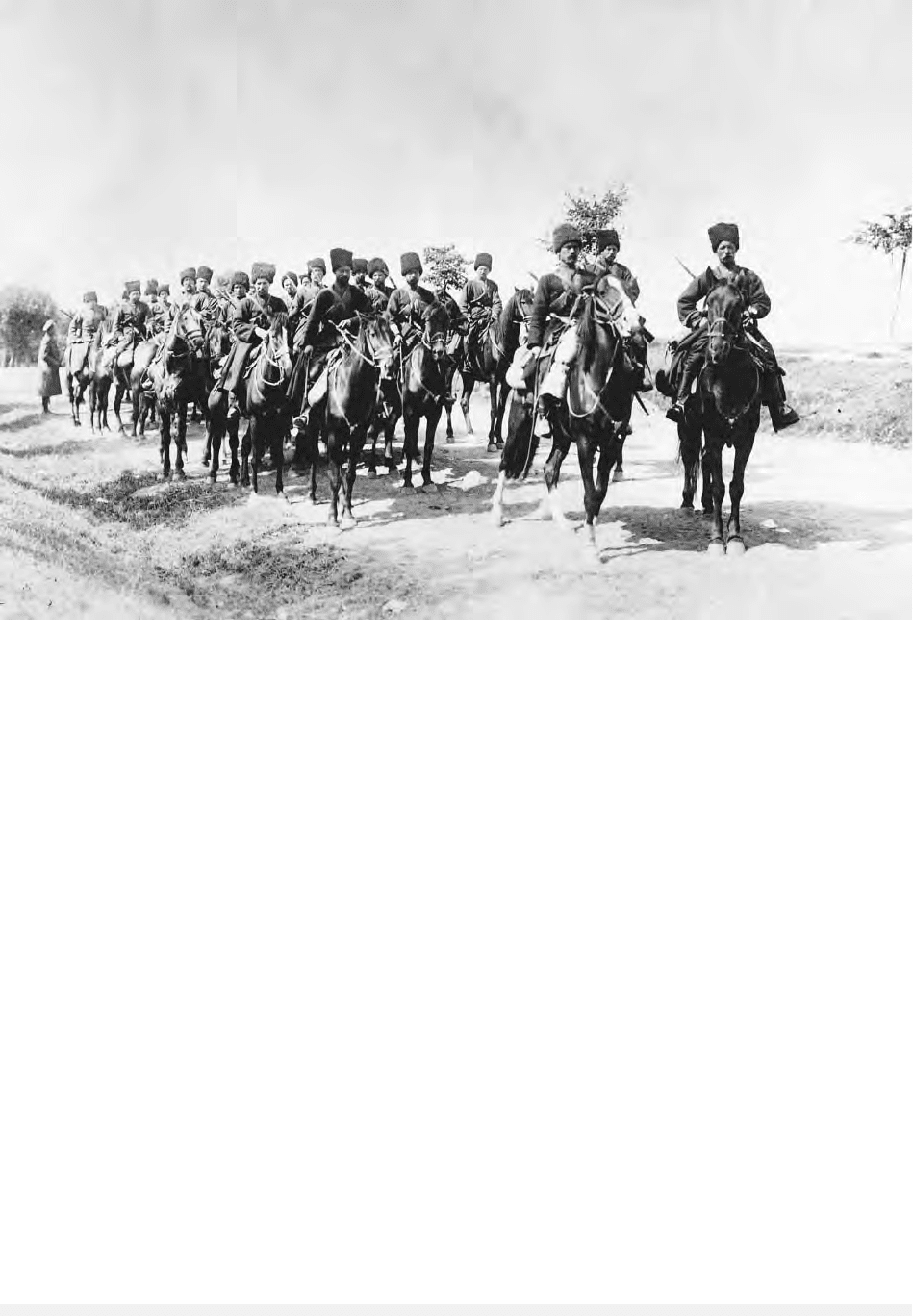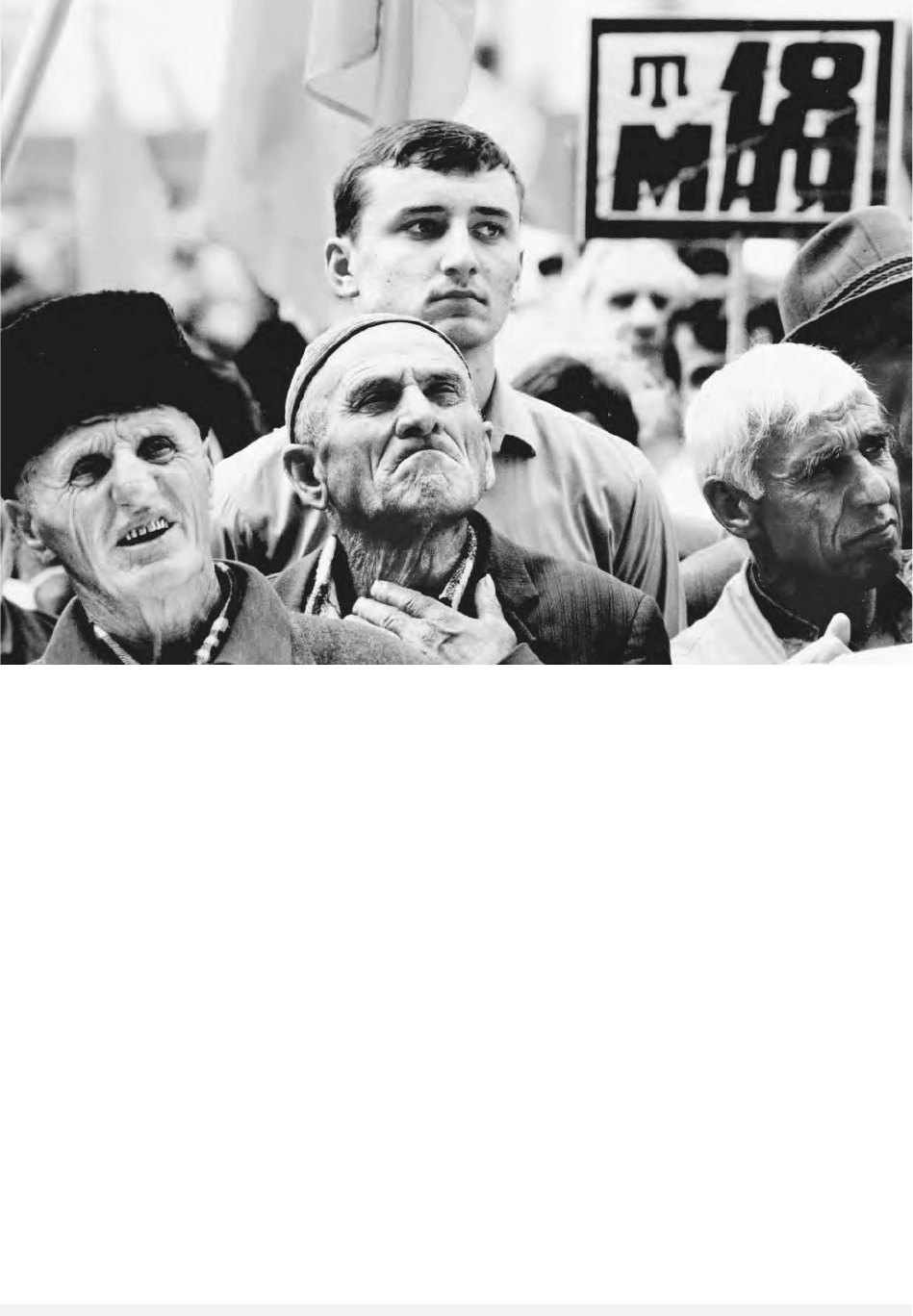Encyclopedia of Russian History
Подождите немного. Документ загружается.


warks against invasion from the south and east,
they were also sensitive to infringements of their
rights and privileges as free men. From the time of
Stepan Razin’s revolt in 1670–1671 until the ris-
ing of Yemelian Pugachev in 1772–1775, they pe-
riodically reacted explosively to encroachments
against their status and freebooting lifestyle.
The service and free Cossack traditions gradually
merged during the eighteenth and early nineteenth
centuries, when the former free Cossack groupings
were either abolished (e.g., the Zaporozhian Sich in
1775) or brought under the complete control (e.g.,
the Don Host also in 1775) of imperial St. Peters-
burg. A series of imperial military administrators
from Grigory Alexandrovich Potemkin through
Alexander Ivanovich Chernyshev imposed measures
that regularized Cossack military service, subordi-
nated local governing institutions to imperial control
and supervision, and integrated local elites into the
ranks of the Russian nobility. Regardless of origin,
by the time of the Crimean War in 1854–1856, all
Cossacks had been transformed into a closed military
estate (sosloviye) subject to mandatory mounted mil-
itary service in exchange for collective title to their
lands and superficial reaffirmation of traditional
rights and privileges. During the Great Reform Era,
War Minister Dmitry Alexeyevich Milyutin toyed
briefly with the idea of abolishing the Cossacks, then
imposed measures to further regularize their gover-
nance and military service. The blunt fact was that
the Russian army needed cavalry, and the Cossack
population base of 2.5 million enabled them to sat-
isfy approximately 50 percent of the empire’s cav-
alry requirements. Consequently, the Cossacks
became an anachronism in an age of smokeless pow-
der weaponry and mass cadre and conscript armies.
Reforms notwithstanding, by the beginning of
the twentieth century, many traditional Cossack
groupings hovered on the verge of crisis, thanks to
a heavy burden of military service, overcrowding in
communal holdings, alienation of land by the Cos-
sack nobility, and an influx of non-Cossack popu-
lation. The revolutions of 1917 and the ensuing
Russian Civil War seriously divided the Cossacks,
COSSACKS
333
ENCYCLOPEDIA OF RUSSIAN HISTORY
Cossacks on the march, 1914. © H
ULTON
-D
EUTSCH
C
OLLECTION
/CORBIS

with a majority supporting the White movement,
while a stubborn minority espoused revolutionary
causes. Following Bolshevik victory, many Cossacks
fled abroad, while those who stayed were persecuted,
gradually disappearing during collectivization as an
identifiable group. During World War II, the Red
Army resurrected Cossack formations, while the
Wehrmacht, operating under the fiction that Cos-
sacks were non-Slavic peoples, recruited its own
Cossack formations from prisoners of war and dis-
sidents of various stripes. Neither variety had much
in common with their earlier namesakes, save per-
haps either remote parentage or territorial affinity.
The same assertion held true for various Cossack-
like groupings that sprang up in trouble spots
around the periphery of the Russian Federation fol-
lowing the disintegration of the Soviet Union in
1991.
See also: CAUCASUS; NATIONALITIES POLICIES, SOVIET;
NATIONALITIES POLICIES, TSARIST; UKRAINE AND
UKRAINIANS
BIBLIOGRAPHY
Barrett, Thomas M. (1999). At the Edge of Empire: The
Terek Cossacks and the North Caucasus Frontier,
1700–1860. Boulder: Westview Press.
Khodarkovsky, Michael. (2002). Russia’s Steppe Frontier:
The Making of a Colonial Empire, 1500–1800. Bloom-
ington: Indiana University Press.
McNeal, Robert H. (1987). Tsar and Cossack, 1855–1914.
London: The Macmillan Press.
McNeill, William H. (1964). Europe’s Steppe Frontier
1500–1800. Chicago: University of Chicago Press.
Menning, Bruce W. (2003). “G. A. Potemkin and A. I.
Chernyshev: Two Dimensions of Reform and Rus-
sia’s Military Frontier.” In Reforming the Tsar’s Army:
Military Innovation in Imperial Russia from Peter the
Great to the Revolution, eds. David Schimmelpenninck
van der Oye and Bruce W. Menning. New York:
Cambridge University Press.
Subtelny, Orest. (2000). Ukraine: A History, 3rd ed.
Toronto: University of Toronto Press.
B
RUCE
W. M
ENNING
COUNCIL FOR MUTUAL
ECONOMIC ASSISTANCE
The decision to establish the Council for Mutual
Economic Assistance, also known as COMECON
and the CMEA, was announced in a joint commu-
niqué issued by Bulgaria, Czechoslovakia, Hun-
gary, Poland, Romania, and the Soviet Union in
January 1949. Albania joined in February 1949;
East Germany in 1950; Mongolia in 1962; Cuba in
1972, and Vietnam in 1978. Albania ceased par-
ticipation in 1961.
COMECON members were united by their com-
mitment to Marxism–Leninism, Soviet–style central
planning, and economic development. COMECON
served as an organizational counterweight first to
the Marshall Plan and then to the European Iron
and Steel Community and its successor, the Euro-
pean Economic Community.
COMECON was effectively directed by a group
outside its formal organization, the Conference
of First Secretaries of Communist and Workers’
Parties and of the Heads of Government of COME-
CON Member Countries. The Soviet Union domi-
nated COMECON. From 1949 to 1953, Stalin used
COMECON primarily to redirect member trade
from outside COMECON to within COMECON and
to promote substitution of domestic production for
imports from outside COMECON. The COMECON
economic integration function was stepped up in
1956, the year of the Soviet invasion of Hungary,
with the establishment of eight standing commis-
sions, each planning for a different economic sec-
tor across the member countries. Notable real
achievements included partial unification of electric
power grids across East European members, coor-
dination of rail and river transport in Eastern Eu-
rope, and the construction of the Friendship pipeline
to deliver Siberian oil to Eastern Europe. In 1971
COMECON initiated a compromise Comprehensive
Program for Socialist Economic Integration as a
counterweight to integration within the European
Economic Community. COMECON continued plan-
ning various integration and coordination efforts
through the 1970s and 1980s. In 1985-1986 these
efforts culminated in the Comprehensive Program
for Scientific and Technical Progress to the Year
2000. With the loss of Soviet control over its East
European trading partners, COMECON tried to sur-
vive as a purely coordinating body but was finally
formally disbanded in June 1991.
COMECON’s impact on Russia was largely eco-
nomic. Russia was the largest republic among the
Soviet Union’s fifteen republics. The Soviet Union
was the dominant member of COMECON. The
strategic purpose of COMECON was to tie Eastern
Europe economically to the Soviet Union. COME-
CON trade became largely bilateral with the Soviet
Union, mostly Russia, supplying raw materials, no-
COUNCIL FOR MUTUAL ECONOMIC ASSISTANCE
334
ENCYCLOPEDIA OF RUSSIAN HISTORY

tably oil, to Eastern Europe in return for manufac-
tured goods, notably machinery and equipment.
This is the opposite of the trade flow between his-
torically dominant countries and their colonies and
dependents. The historical norm is for raw materi-
als to flow from the colonies and dependents to the
dominant center, which exports advanced manu-
factures and services in return. The comparative ad-
vantage for Russia within COMECON was,
however, as a raw material and fuel exporter. Rus-
sia’s loss was that it received in return shoddy and
obsolescent COMECON machinery and equipment
rather than Western machinery with Western tech-
nology embedded in it. The Comprehensive Program
for Scientific and Technical Progress to the Year
2000 was only one effort to remedy this problem.
Russia also lost out on its potential gains from
OPEC’s increase in the price of oil beginning in 1973.
COMECON trade was conducted in “transfer-
able rubles,” basically a bookkeeping unit good only
to buy imports from other COMECON partners.
However, most purchases and their prices were bi-
laterally negotiated between the COMECON trade
partners. So, the real value of a country’s trans-
ferable ruble balance was indeterminate. Russian oil
was sold by the Soviet Union to COMECON part-
ners for transferable rubles. OPEC dramatically in-
creased the dollar value of oil exports beginning in
1973. In 1975 COMECON agreed that the trans-
ferable ruble price of oil be indexed to the global
dollar price, specifically the moving average for the
past three years in 1975 and the past five years for
every year thereafter. Thus, the prices of Soviet oil
exports to COMECON lagged the global price rises
through the late 1970s. Only when global oil prices
dropped in the early 1980s did the transferable ru-
ble price of Soviet oil catch up. Overall, the Soviet
Union paid for its East European “empire” by sell-
ing its raw inputs, especially oil, for less than world
market prices and by receiving less technologically
advanced manufactured goods in return. Much of
this cost was borne by Russia.
See also: ELECTRICITY GRID; EMPIRE, USSR AS; FOREIGN
TRADE
BIBLIOGRAPHY
Brabant, Jozef M. van. (1980). Socialist Economic Inte-
gration: Aspects of Contemporary Economic Problems in
Eastern Europe. Cambridge, UK: Cambridge Univer-
sity Press.
Marrese, Michael, and Vanous, Jan. (1983). Soviet Sub-
sidization of Trade with Eastern Europe: A Soviet Per-
spective. Berkeley, CA: Institute of International
Studies, University of California.
Metcalf, Lee Kendall. (1997). The Council of Mutual Eco-
nomic Assistance: The Failure of Reform. New York:
Columbia University Press.
Zwass, Adam. (1989). The Council for Mutual Economic
Assistance: The Thorny Path from Political to Economic
Integration. Armonk, NY: M.E. Sharpe.
D
ANIEL
R. K
AZMER
COUNCIL OF MINISTERS, IMPERIAL See CAB-
INET OF MINISTERS, IMPERIAL.
COUNCIL OF MINISTERS, SOVIET
In 1946, Sovnarkom—Sovet Ministrov, the gov-
ernment of the USSR—was renamed the Council of
Ministers to bring the USSR into line with practice
in other great powers. Josef Stalin remained as
chairperson until 1953. He was followed by Georgy
Malenkov until 1955; then Nikolai Bulganin until
1958; Nikita Khrushchev, from 1958 to 1964;
Alexei Kosygin, 1964–1980; Nikolai Tikhonov,
1980–1985; and Nikolai Ryzhkov, 1985–1990.
Membership of the Council of Ministers consisted
of the chairperson, first deputy chairperson, deputy
chairpersons, ministers of the USSR and chairper-
sons of State Committees of the USSR. Chairper-
sons of Councils of Ministers of Union republics
were ex officio members of the Council of Minis-
ters of the USSR. Under the 1977 constitution
membership could also include “the heads of other
organs and organizations of the USSR.” This al-
lowed the chairperson of the Central Council of
Trade Unions or the first secretary of the Com-
munist Youth League (Komsomol) to serve on the
Council of Ministers. The first Council of Ministers
formed under this constitution comprised 109
members.
Ministries and State Committees, as with the
commissariats in Sovnarkom, were of two varieties:
“union-republican,” which functioned through par-
allel apparatuses in identically named republican
ministries, and “all-union,” which worked by direct
control of institutions in the republics or through
organs in the republics directly subordinate to the
USSR minister. Groups of related ministries were
supervised by senior Party leaders serving as deputy
chairpersons of the Council of Ministers. In the early
postwar years the tendency toward subdivision of
COUNCIL OF MINISTERS, SOVIET
335
ENCYCLOPEDIA OF RUSSIAN HISTORY

ministries, apparent in Sovnarkom during the
1930s, continued until 1948, but it was then fol-
lowed by a period of amalgamation until 1949, and
more modest expansion until 1953. Immediately af-
ter Stalin’s death membership of the Council of Min-
isters was reduced from eighty-six to fifty-five,
groups of economic ministries being amalgamated,
but this was only temporary, and by the end of
1954 membership had increased again to seventy-
six and continued to increase more slowly from that
time.
Theoretically responsible and accountable to the
Supreme Soviet of the USSR, with membership sup-
posedly decided by that institution, but in reality
by the Politburo, the Council of Ministers was em-
powered to deal with all matters of state adminis-
tration of the USSR outside the competence of the
Supreme Soviet, issuing decrees and ordinances and
verifying their execution. According to the 1936 and
1977 Constitutions, the Council of Ministers was
responsible for direction of the national economy
and economic development; social and cultural de-
velopment, including science and technology; the
state budget; planning; defense, state security; gen-
eral direction of the armed forces; foreign policy;
foreign trade and economic; and cultural and sci-
entific cooperation with foreign countries.
By a law of 1978, meetings of the Council of
Ministers were to be convened every three months
and sessions of its Presidium “regularly (when the
need arises).” This institution, created in 1953, con-
sisting of the chairperson, first deputy chairperson
and deputy chairpersons of the Council of Minis-
ters, functioned only intermittently until 1978. Of-
ten described in Western literature as an “inner
cabinet,” it then became primarily responsible for
the directions of economic affairs.
See also: BULGANIN, NIKOLAI ALEXANDROVICH; BUREAU-
CRACY, ECONOMIC; KHRUSHCHEV, NIKITA SERGEY-
VICH; KOSYGIN, ALEXEI NIKOLAYEVICH; SOVNARKOM;
STALIN, JOSEF VISSARIONOVICH; STATE COMMITTEES
BIBLIOGRAPHY
Unger, Aryeh. (1981). Constitutional Development in the
USSR: A Guide to the Soviet Constitutions. London:
Methuen.
D
EREK
W
ATSON
COUNCIL OF PEOPLE’S COMMISSARS See
SOVNARKOM.
COUNTERREFORMS
The Counterreforms of the 1880s and 1890s refer
to the body of domestic policies adopted under Tsar
Alexander III as an ideological response and reac-
tion to the transformations of the earlier Great Re-
forms undertaken by so-called “enlightened”
bureaucrats with the tacit approval of the assassi-
nated Tsar Alexander II. They were also a response
to radicalism growing out of the reform milieu.
The conservatives believed the Empire was threat-
ened. Whereas the Great Reforms of the period
1855–1881 in the broadest sense intended to ren-
ovate the body politic and instill new principles of
self-government, rule of law, citizenship, and even
to introduce at the very end a veiled form of elite
representation in the legislative process, the coun-
terreforms of the new Tsar and his conservative ad-
visers within and outside the bureaucracy aimed to
reverse such changes and to reassert traditional au-
tocracy and nationhood and the more manageable
and corporatist society organized by legal estates.
Immediately after Alexander II’s assassination in
March 1881, the new government moved quickly
to remove Loris-Melikov and remaining reformers
from the government. On April 29, 1881, the Tsar
declared that Russia would always remain an au-
tocracy. The reform era was over.
The counterreforms were ushered in by the
laws on state order and the pacification of society
of August 14, 1881. These laws, sponsored by Min-
ister of Internal Affairs, N. P. Ignat’ev, provided for
two types of martial law (condition of safeguard
and extraordinary safeguard) that gave the police
and administration enhanced powers above and be-
yond those residing in the new judicial system.
These decrees remained in force until just days be-
fore the February Revolution of 1917. On August
27, 1882, the government introduced “temporary
rules on the press,” which gave more censorship
power to the administration. Minister of Internal
Affairs D. A. Tolstoy then introduced a new Uni-
versity Statute on August 23, 1884. This effectively
repealed university corporate autonomy and bu-
reaucratized the administration of higher educa-
tion. It also placed limits on higher education for
women. Finally a cluster of three major acts placed
new administrative restrictions on the institutions
of self-government, the zemstvos and town dumas.
These laws of June 12, 1890 (zemstvo) and June
11, 1892 (town duma) changed the electoral laws
to favor the gentry in the case of the zemstvos and
large property owners in the cities. Many recent
COUNTERREFORMS
336
ENCYCLOPEDIA OF RUSSIAN HISTORY

voters in town and countryside alike were disen-
franchised. In addition new bureaucratic instances
were established to shore up administrative control
over self-government. This would call forth oppo-
sition in the form of a zemstvo movement that
would be instrumental in the 1905 Revolution. Per-
haps most symbolic of all the counterreforms was
the notorious act of July 12, 1889 that created the
Land Captains (zemskie nachal’niki). These were ap-
pointed government officials in the countryside
who combined administrative, police, and judicial
authority. The aim was once again administrative
control, this time over the relatively new peasant
institutions and indeed over peasant life in the
broadest sense. Control rather than building a new
society from the grassroots was the central point
of these counterreforms. The counterreforms and
their supporting ideology extended into the reign
of Nicholas II, making it that much more difficult
for the regime to solve its social and political prob-
lems. They in fact made revolution more likely. The
counterreforms co-existed uneasily with more for-
ward-looking economic policies even during the
reign of Alexander III.
See also: ALEXANDER III, NICHOLAS II
D
ANIEL
O
RLOVSKY
COUNTRY ESTATES
Country estates, some dating back to the fifteenth
century, originated as land grants from the crown
to trusted servitors. The Russian empire expanded
rapidly, particularly in the eighteenth century, and
along with it the estate network, which ultimately
stretched from the Baltic Sea to the Crimean Penin-
sula, and from the Duchy of Warsaw to the Ural
Mountains. During the estate’s golden age from the
reign of Catherine II to the War of 1812, wealthy
nobles who had retired from state service built
thousands of magnificent houses, most in neoclas-
sical style, surrounded by elegant formal gardens
and expansive landscape parks.
Until the emancipation of the serfs in 1861, es-
tates were private princedoms (owned exclusively
by nobles) supported by involuntary labor. Thus
in some respects the pre-emancipation estate was
comparable to the plantation of the American
south. Its uniqueness lay in its scores of highly
trained serf craftsmen and artists, some of whom
founded dynasties of acclaimed artists. Very
wealthy landowners took pride in having at hand
accomplished architects and painters, musicians,
actors, and dancers for entertainment, and cabi-
netmakers, gilders, embroiderers, lace-makers and
other skilled craftsmen who produced all the lux-
ury items they needed. Hence the greatest estates,
in addition to being economic centers, were also
culturally self-contained worlds that facilitated the
rapid development of Russian culture.
Estates also served as important places of in-
spiration and creativity for Russia’s most renowned
authors, painters, and composers. For the intellec-
tual and artistic elite, country estates were Arca-
dian retreats, places of refuge from the constraints
of city life. Alexander Pushkin’s Eugene Onegin, Ivan
Turgenev’s A Sportsman’s Sketches and Fathers and
Sons, Leo Tolstoy’s War and Peace and Anna Karen-
ina, and Pyotr Tchaikovsky’s 1812 Overture are
among the many Russian masterpieces composed
on a country estate.
After 1861 many small estate owners, unable
to survive the loss of their unpaid labor, sold their
holdings (a situation memorialized in Anton
Chekhov’s The Cherry Orchard). On larger estates a
system similar to sharecropping was devised; these
estates retained their economic strength until the
revolution. Up to World War I Russia exported
tons of grains and other agricultural products pro-
duced on thousands of country estates. In non-
black-earth (non-chernozem) regions, enterprises
on estates such as Khmelita (Smolensk guberniya),
exporting prize-winning cheeses, Glubokoye (Pskov
guberniya), producing wooden lanterns sold in
England, and Polotnyany Zavod (Kaluga gu-
berniya), which manufactured the linen paper used
for Russian currency, also contributed to the econ-
omy.
The Bolshevik revolution destroyed the coun-
try estate, and with it much of the provincial eco-
nomic and cultural infrastructure. Some estate
houses have survived as orphanages, sanitariums,
institutes, or spas. In the 1970s certain demolished
estates associated with famous cultural figures
(such as Pushkin’s Mikhailovskoye and Turgenev’s
Spasskoye-Lutovinovo) were rebuilt. A few mu-
seum estates such as Kuskovo and Ostankino in
Moscow and the battered manor houses of the
Crimea still offer tourists a glimpse of Russia’s pre-
Revolutionary estate splendor.
See also: PEASANTRY; SERFDOM; SLAVERY
COUNTRY ESTATES
337
ENCYCLOPEDIA OF RUSSIAN HISTORY

BIBLIOGRAPHY
Blum, Jerome. (1961). Lord and Peasant in Russia. Prince-
ton, NJ: Princeton University Press.
Roosevelt, Priscilla. (1995). Life on the Russian Country Es-
tate: A Social and Cultural History. New Haven, CT:
Yale University Press.
P
RISCILLA
R
OOSEVELT
COURT, HIGH ARBITRATION
The High Arbitration Court is at the top of the sys-
tem of arbitration courts. These courts were orig-
inally created in the Soviet period as informal
tribunals to resolve problems in implementing eco-
nomic plans. In the post-communist era they have
been reorganized into a system of courts with ex-
clusive jurisdiction over lawsuits among businesses
and between businesses and government agencies.
While for historical reasons they are called “arbi-
tration” courts, in fact they are formal state courts
with compulsory jurisdiction and have nothing to
do with private arbitration of disputes.
The structure of the courts is governed by the
1995 Constitutional Law on Arbitration Courts.
Beneath the High Arbitration Court there are ten
appellate courts, each with jurisdiction over a sep-
arate large area of the country, and numerous trial
courts. The High Arbitration Court is responsible
for the management of the entire arbitration court
system. Procedural rules are provided by the 2002
Arbitration Procedure Code. Cases are heard in the
first instance in the trial court. Either party may
then appeal to an appellate instance within the trial
court, and may further appeal to the appropriate
appellate court. There is no right to appeal to the
High Arbitration Court; rather, review by the High
Arbitration Court is discretionary with the Court.
The High Arbitration Court has original jurisdic-
tion over two types of cases: (1) those concerning
the legality of acts of the Federation Council, the
State Duma, the president, or the government; and
(2) economic disputes between the Russian Federa-
tion and one of its eighty–nine subjects. The High
Arbitration Court also has, and frequently exer-
cises, the power to issue explanations on matters
of judicial practice, for the guidance of the lower
courts, lawyers, and the public. The Court also
publishes many of its decisions in individual cases
on the Internet.
See also: COURT, SUPREME; LEGAL SYSTEMS.
BIBLIOGRAPHY
Hendley, Kathryn. (1998). “Remaking an Institution: The
Transition in Russia from State Arbitrazh to Arbi-
trazh Courts.” American Journal of Comparative Law
46:93-127.
Hendley, Kathryn; Murrell, Peter; and Ryterman, Randi.
(2001). “Law Works in Russia: The Role of Law in
Interenterprise Transactions.” In Assessing the Value
of Law in Transition Economies, ed. Peter Murrell. Ann
Arbor: University of Michigan Press.
Oda, Hiroshi. (2002). Russian Commercial Law. The
Hague, Netherlands: Kluwer Law International.
P
ETER
B. M
AGGS
COURT, SUPREME
The Supreme Court is “the highest judicial body for
civil, criminal, administrative and other cases
falling within the jurisdiction of courts of general
jurisdiction” under Article 126 of the Russian Con-
stitution. The courts of general jurisdiction hear all
cases except: (1) lawsuits among businesses and be-
tween businesses and government agencies, which
are heard by the Arbitration Court system; and (2)
certain Constitutional issues, which are heard by
the Constitutional Court. Beneath the Supreme
Court are the highest courts of each of the
eighty–nine subjects of the Russian Federation and
the military courts. Beneath the courts of the sub-
jects of the Russian Federation are a large number
of district courts. Still lower in the hierarchy are
Justice of the Peace Courts, which deal with rela-
tively unimportant cases. The court structure and
the relations between the courts are governed by
the 1996 Constitutional Law on the Judicial Sys-
tem of the Russian Federation. Procedural rules are
provided by the 2001 Criminal Procedure Code and
the 2002 Civil Procedure Code.
The Supreme Court has separate divisions for
civil cases, criminal cases, and military cases. It has
a President and a Presidium consisting of several
high officers of the court. It also has a plenary ses-
sion in which all the judges meet together. The Ju-
dicial Department of the Supreme Court handles
the administration of all the courts of general ju-
risdiction. Most cases are heard by the Supreme
Court on appeal from or petition for review of
lower court decisions. Because the court sits in sep-
arate divisions and has a large number of judges,
it is able to review a very large number of lower
court cases. However, a few very important cases
COURT, HIGH ARBITRATION
338
ENCYCLOPEDIA OF RUSSIAN HISTORY

are heard by the Court in first instance. There is a
mechanism for an appeal of these decisions to a
higher level of the Supreme Court itself. The ple-
nary session of the Court also has the power to is-
sue interpretations of the law for the guidance of
the lower courts. The interpretations and many
other Court decisions are published at its web site.
As the result of easy availability of these interpre-
tations and decisions, lawyers are increasingly
studying and citing Supreme Court rulings.
The Supreme Court has in some cases refused
to apply statute laws on the basis that they con-
tradicted the Constitution. Gradually, however, its
policy changed. When in doubt on the constitu-
tionality of a law, the Supreme Court has typically
referred the question to the Constitutional Court.
However, the Supreme Court frequently hears cases
concerning the conformity of administrative regu-
lations to the Constitution and laws, and fre-
quently invalidates such regulations. The Supreme
Court of the twenty–first century is very different
from the Supreme Court of the Soviet period, even
though the court structure is little changed. In the
Soviet period the Court was subservient to the
Party authorities. The court did not control judi-
cial administration, which was managed by the
Ministry of Justice. It did cite the Constitution, but
never refused to apply a law on the basis of the
Constitution alone.
See also: COURT, HIGH ARBITRATION; LEGAL SYSTEMS.
BIBLIOGRAPHY
Burnham, William, and Danilenko, Gennady M. (2000).
Law and Legal System of the Russian Federation, 2nd
ed. Huntington, NY: Juris.
Krug, Peter. (1997). “Departure from the Centralized
Model: the Russian Supreme Court and Constitu-
tional Control of Legislation.” Virginia Journal of
International Law 37:725-786.
Maggs, Peter B. (1997) “The Russian Courts and the
Russian Constitution.” Indiana International and
Comparative Law Review 8:99-117.
P
ETER
B. M
AGGS
CRIMEA
Russian hegemony was established over the Crimea
region in 1783 when the Tsarist empire destroyed
the Crimean Tatar state. By the second half of the
nineteenth century the Crimean population had de-
clined to 200,000, of which half were Tatars. This
proportion continued to decline as Slav migration
to the region continued in the next century through
industrialization, the building of the Black Sea Fleet,
and tourism. By the 1897 and 1926 censuses the
Tatar share of the population had declined to 34
and 26 percent respectively.
During the civil war of 1917–1922, Crimea
was claimed by the independent Ukrainian state,
which obtained it under the terms of the 1918
Brest-Litovsk Treaty. But Crimea was also the scene
of conflict between the Whites and Bolsheviks. In
October 1921 Crimea was included within the
Russian Federation (RSFSR) as an autonomous re-
public with two cities (Sevastopol and Evpatoria)
under all-union jurisdiction.
Crimea’s ethnic composition changed in May
1944 when nearly 200,000 Tatars and 60,000
other minorities were deported to Central Asia. It
is estimated that up to 40 percent of the Tatars died
during the deportation. A year later Crimean au-
tonomy was formally abolished, and the peninsula
was downgraded to the status of oblast (region) of
the Russian Federation. All vestiges of Tatar influ-
ence were eradicated.
Crimea’s status was again changed in 1954
when Soviet leader Nikita Khrushchev transferred
it to the Ukrainian SSR. It remained an oblast un-
til 1991, when a popularly supported referendum
restored its status to an autonomous republic
within Ukraine. Tatars began to return to Crimea
in the Gorbachev era, but they still only accounted
for 15 percent of the population, with the remain-
der of the population divided between Russians
(two-thirds) and russified Ukrainians.
The status of Crimea and the city of Sevastopol,
and the division of the Soviet Black Sea Fleet sta-
tioned on the peninsula, were the object of acri-
monious dispute between Ukraine and Russia in the
post-Soviet era. The Russian parliament repeatedly
voted to demand that Ukraine return both Crimea
and Sevastopol. Furthermore, the parliament ar-
gued that legally they were Russian territory and
that Russia, as the successor state to the USSR, had
the right to inherit Sevastopol and the Black Sea
Fleet.
This dispute was not resolved until May 1997,
when Ukraine and Russia signed a treaty that rec-
ognized each other’s borders. The treaty was
quickly ratified by the Ukrainian parliament
(Rada), but both houses of the Russian parliament
CRIMEA
339
ENCYCLOPEDIA OF RUSSIAN HISTORY

only ratified it after intense lobbying from Ukraine
in October 1998 and February 1999.
The resolution of the question of the owner-
ship of Crimea and Sevastopol between 1997 and
1999 also assisted in the division of the Black Sea
Fleet. Russia inherited 80 percent of the fleet and
obtained basing rights scheduled to expire in 2017.
The situation was also stabilized by Crimea’s adop-
tion in October 1998 of a constitution that for the
first time recognized Ukraine’s sovereignty.
Within Crimea the Tatars have been able to mo-
bilize large demonstrations, but their small size has
prevented them from having any significant influ-
ence on the peninsula’s politics. Between 1991 and
1993 the former communist leadership of Crimea,
led by Mykola Bagrov, attempted to obtain signif-
icant concessions from Kiev in an attempt to max-
imize Crimea’s autonomy. This autonomist line
was replaced by a pro-Russian secessionist move-
ment that was the most influential political force
between 1993 and 1994; its leader Yuri Meshkov
was elected Crimean president in January 1994. The
secessionist movement collapsed between 1994 and
1995 due to internal quarrels, lack of substantial
Russian assistance, and Ukrainian economic, polit-
ical, and military pressure. The institution of a
Crimean presidency was abolished in March 1995.
From 1998 to 2002 the peninsula was led by Com-
munists, who controlled the local parliament, and
pro-Ukrainian presidential centrists in the regional
government. In the 2002 elections the Communists
lost their majority in the local parliament, and it,
like the regional government, came under the con-
trol of pro-Ukrainian presidential centrists.
See also: BLACK SEA FLEET; CRIMEAN KHANATE; CRIMEAN
TATARS; CRIMEAN WAR; SEVASTOPOL; TATARSTAN
AND TATARS; UKRAINE AND UKRAINIANS
BIBLIOGRAPHY
Allworth, Edward, ed. (1988). Tatars of the Crimea: Their
Struggle for Survival. Durham, NC: Duke University
Press.
Kuzio, Taras. (1994). “The Crimea and European Secu-
rity.” European Security 3(4): 734–774.
Kuzio, Taras. (1998). Ukraine: State and Nation Building
(Routledge Studies of Societies in Transition, 9). Lon-
don: Routledge.
Lazzerini, Edward. (1996). “Crimean Tatars.” In The Na-
tionalities Question in the Post-Soviet States, ed. Gra-
ham Smith. London: Longman.
T
ARAS
K
UZIO
CRIMEAN KHANATE
One of the surviving political elements of the
Golden Horde, the Crimean Khanate comprised all
of the Crimean peninsula, except for the southern
and western coast, which was a province of the Ot-
toman Empire after 1475 (Kefe Eyalet), and sur-
vived until 1783 when it was annexed by the
Russian Empire. The Khanate’s ruling dynasty, the
Girays, established its residence and “capital” in the
valley of Bahçe Saray, from which it ruled most of
the peninsula, and conducted relations with the Ot-
tomans in the south.
Among the early Crimean khans, most impor-
tant were Mengli Giray I (1467–1476 and
1478–1515), who is considered the “founder” of
the Khanate; Sahib Giray I (1532–1551), who com-
peted with Ivan IV for control of Kazan and As-
trakhan, and lost; and Devlet Giray I (1551–1577),
who led a campaign against Moscow. It was Mengli
Giray who used Italian architects to build the large
khan’s palace and the important Zincirli Medrese
in Bahçe Saray and, through patronizing artists
and writers, establishing the khanate as a Sunni
Muslim cultural center.
The khanate had a special relationship with the
Ottoman Empire. Never Ottoman subjects, the
Khanate’s Giray dynasty was considered the cru-
cial link between the Ottomans and the Mongols,
particularly Ghenghis Khan. Had the Ottoman dy-
nasty died out, the next Ottoman sultan would
have been selected from the Giray family. Through-
out the sixteenth and seventeenth centuries, the Gi-
rays often provided military support for Ottoman
campaigns, in Hungary and in Iran. Crimean
mounted archers were considered by the Ottomans
to be among the most reliable and effective elements
of their armies.
So far as the Russians were concerned, the most
important feature of the khanate was the latter’s
dependence on raiding Muscovite lands for eco-
nomic benefit. Crimean Tatars frequently “har-
vested the steppe” and brought Russian, Ukrainian,
and Polish peasants to Crimea for sale. Slave mar-
kets operated in Kefe and Gozleve, where merchants
from the Ottoman Empire, Iran, and Egypt pur-
chased Slavic slaves for export. Several raids reached
as far as Moscow itself. Slave market tax records
indicate that more than a million were sold in
Crimea in the sixteenth and seventeenth centuries.
CRIMEAN KHANATE
340
ENCYCLOPEDIA OF RUSSIAN HISTORY

Eighteenth-century Russian governments tried
to bring an end to these raids. An invasion of
Crimea in 1736 succeeded in destroying much of
the khanate’s capital Bahçesaray, including the
palace, though the Russian army soon abandoned
that effort. The Girays were able to rebuild much
of the city over the next ten years.
It was left to Catherine II to bring an end the
khanate, in 1783. Russian victories over the Ot-
tomans resulted in, first, the Treaty of Karasu
Bazaar between Russia and the Khanate in No-
vember 1772, followed by the Treaty of Küçük
Kaynarca between Russia and the Ottoman Empire
in 1774. Karasu Bazaar established an “alliance and
eternal friendship” between the khanate and Rus-
sia; the second cut all ties between the khanate and
the Ottoman Empire.
For nine years, Catherine II worked with the
last Crimean Khan, Šahin Giray, in an experiment
in “independence,” implementing some of her “en-
lightened” political ideas in a Muslim, Tatar soci-
ety. Recognizing failure in this venture, Catherine
annexed the khanate and the rest of the Crimean
peninsula to the empire in 1783.
See also: CATHERINE II; CRIMEAN TATARS; GOLDEN HORDE;
NATIONALISM IN TSARIST EMPIRE
BIBLIOGRAPHY
Fisher, Alan. (1970). The Russian Annexation of the Crimea,
1772–1783. Cambridge, UK: Cambridge University
Press.
Fisher, Alan. (1999). A Precarious Balance: Conflict, Trade,
and Diplomacy on the Russian-Ottoman Frontier. Is-
tanbul: Isis Press.
A
LAN
F
ISHER
CRIMEAN TATARS
A Turkic people who settled the Crimean peninsula
over the two hundred years after Batu Khan’s con-
quest, the Tatars of the Crimea came from Central
Asia and Anatolia. By 1450, almost the whole of
the peninsula north of the coastal mountains was
Tatar land. The Tartat language was a combina-
tion of the Turkish of the Anatolian Seljuks and the
Chagatay Turkic of the Tatar rulers of the Volga
region, though by the end of the fifteenth century,
Crimean Tatar was a dialect different from both.
In the fifteenth century, the Crimean Tatars es-
tablished a state (khanate) and a ruling dynasty
(Giray) with its political center first in Solhat and
later in Bahçesaray. This khanate was closely as-
sociated with the Ottoman Empire to the south,
though it retained its sovereignty. No Ottoman of-
ficials exercised authority within the lands of these
Tatars. Crimean Tatar authors wrote histories and
chronicles that emphasized distinctions between
Tatars and other Turkic peoples, including the Ot-
tomans.
As the Crimean Tatar economy depended on the
slave trade and raids into Russian and other Slavic
lands, it was inevitable that Russia would strive to
gain dominance over the peninsula. But it was only
in the eighteenth century that Russia had sufficient
power to defeat, and, ultimately, annex the penin-
sula and incorporate the remaining Tatars into their
empire. The annexation took place in 1783.
Russian domination put enormous pressures
on the Tatars—causing many to emigrate to the
Balkans and Ottoman Empire during the nine-
teenth century. One of the Tatar intellectuals, Is-
mail Bey Gaspirali, tried to establish an educational
system for the Tatars that would allow them to
survive, as Tatars and as Muslims, within the
Russian Empire. He had substantial influence over
other Turkic Muslims within the empire, an in-
fluence that spread also to Turkish intellectuals in
Istanbul.
Throughout the nineteenth century the Rus-
sian government encouraged Russian and Ukrain-
ian peasants to settle on the peninsula, placing ever
greater pressures on the Tatar population. Al-
though the Revolution of 1917 promised some re-
lief to the Tatars, with the emergence of “national
communism” in non-Russian lands, the Tatar in-
tellectual and political elites were destroyed during
the Stalinist purges.
The German occupation of Crimea after 1941
produced some Crimean Tatar collaboration,
though no greater proportion of Tatars fought
against the USSR than did Ukrainians or Belorus-
sians. Nevertheless, the entire Crimean Tatar na-
tionality was collectively punished in 1944, and
deported en masse to Central Asia, primarily
Uzbekistan. In the 1950s, Crimea was assigned to
the Ukrainian SSR, at the three hundredth an-
niversary of Ukraine’s annexation to the Russian
Empire. Ukrainians and Russians resettled Tatar
homes and villages.
CRIMEAN TATARS
341
ENCYCLOPEDIA OF RUSSIAN HISTORY

Many Tatars fled to Turkey, where they joined
descendants of Tatars who had emigrated from
Crimea in the nineteenth and twentieth centuries.
In the early 2000s it was estimated that there were
more than 5 million Crimean Tatar descendants
who were citizens of the Republic of Turkey. They
have been thoroughly assimilated as Turks, though
they continue Tatar cultural and literary activities.
During the next thirty-five years, Tatars in
Central Asian exile continued to maintain their na-
tional identity, through cultural and political
means. They published, in Tatar, a newspaper in
Tashkent, Lenin Bayragï, and united their efforts
with various Soviet dissident groups. Some at-
tempted to return to the Crimean peninsula, with
modest success.
With the collapse of the USSR, and the new in-
dependence of the Ukraine, continued efforts have
been made by Tatars to reestablish some of their
communities on the peninsula. Crimean Tatars,
however, remain one of the many “nationalities”
of the former USSR that have not been able to es-
tablish a new nation.
See also: DEPORTATIONS; GASPIRALI, ISMAIL BEY; ISLAM;
NATIONALITIES POLICIES, SOVIET; NATIONALITIES
POLICIES, TSARIST.
BIBLIOGRAPHY
Allworth, Edward A., ed. (1998). The Tatars of Crimea :
Return to the Homeland: Studies and Documents.
Durham, NC: Duke University Press.
Fisher, Alan. (1978). Crimean Tatars. Stanford, CA:
Hoover Institution Press.
Fisher, Alan. (1998). Between Russians, Ottomans and
Turks: Crimea and Crimean Tatars. Istanbul: Isis Press.
A
LAN
F
ISHER
CRIMEAN TATARS
342
ENCYCLOPEDIA OF RUSSIAN HISTORY
Crimean Tatars mark the fifty-fourth anniversary of Stalin’s order to deport their ancestors from the Crimean peninsula, May 18,
1998. P
HOTOGRAPH BY
S
ERGEI
S
VETLITSKY
/A
SSOCIATED
P
RESS
. R
EPRODUCED BY PERMISSION
.
